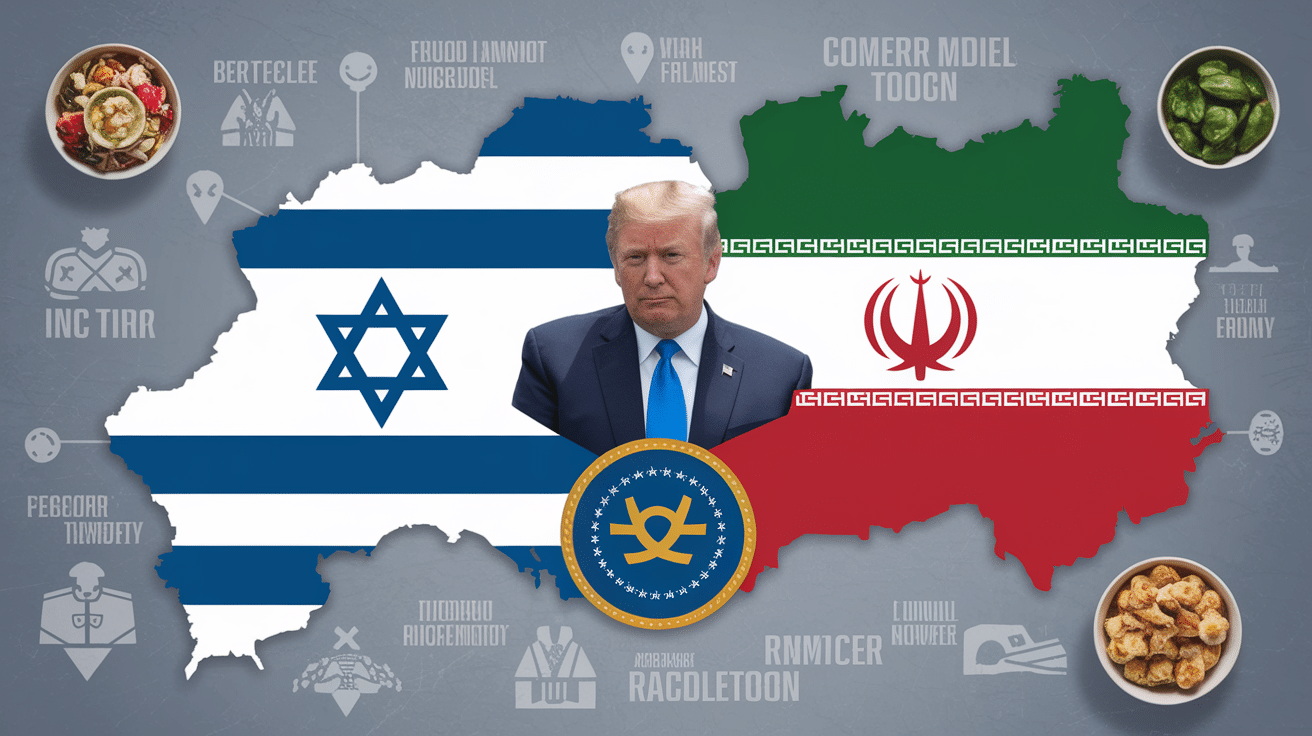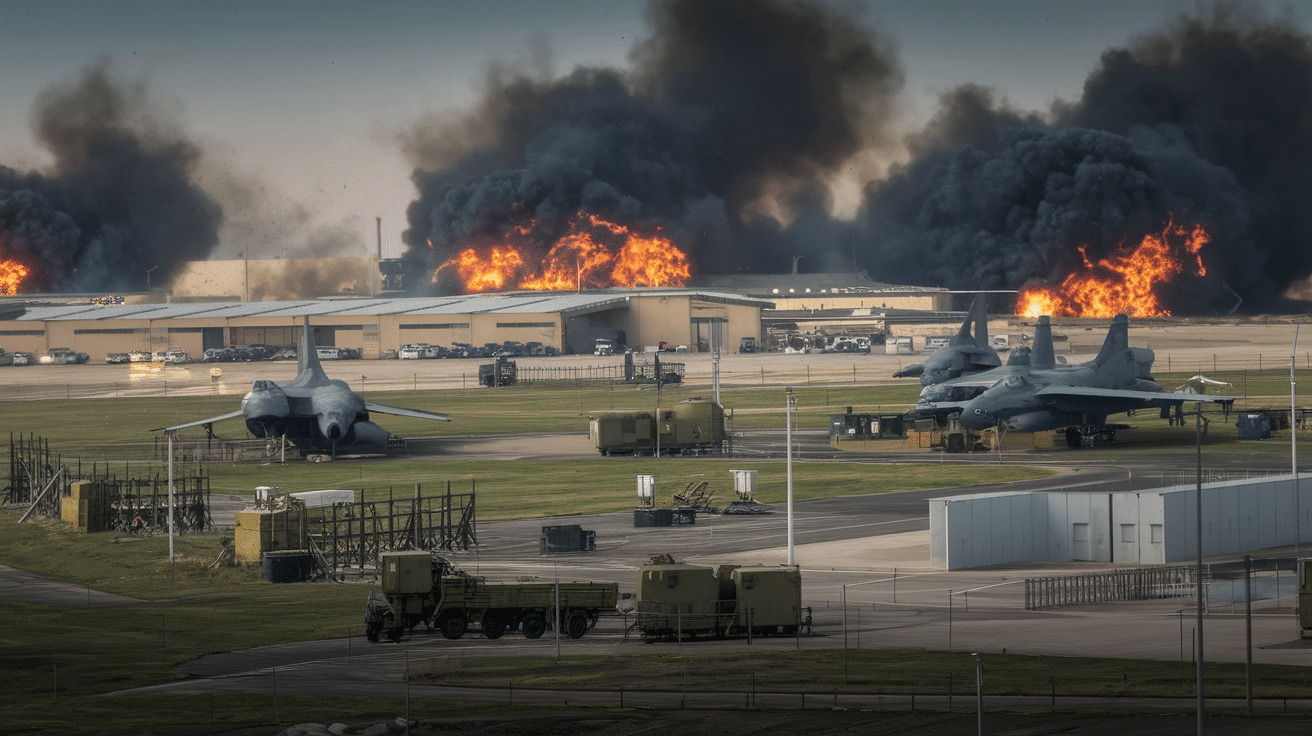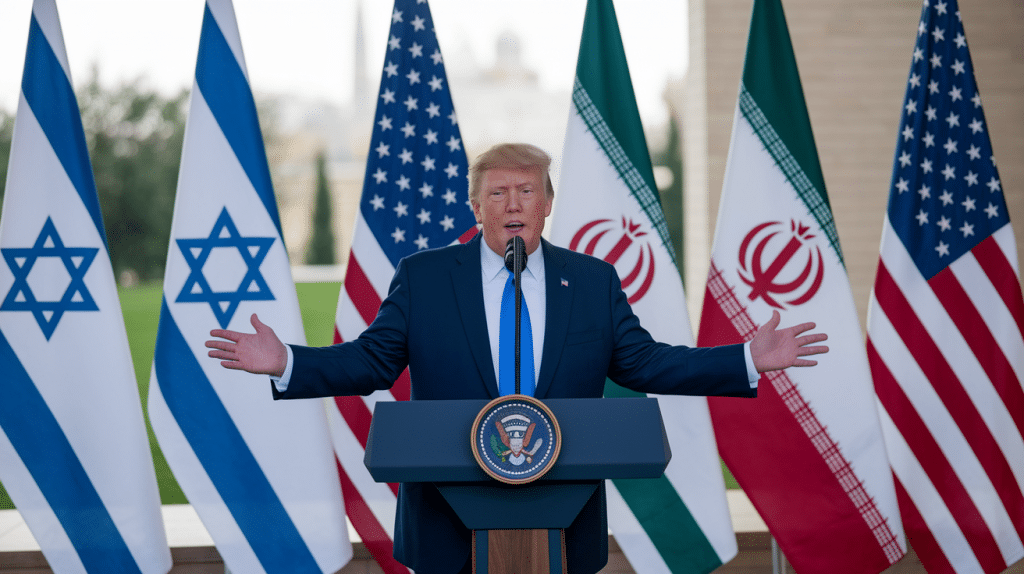Trump has declared a ceasefire between Israel and Iran, signaling a potential pause in the recent intense conflict that included missile strikes and military operations. As you follow these developments, be aware that while the truce aims to de-escalate tensions, fresh attacks, including a significant strike on Al Udeid Air Base in Qatar, have heightened regional risks. Your understanding of this evolving situation is vital as it impacts not only Middle East stability but also global energy markets and security dynamics.
Historic Ceasefire Announcement and Its Implications
The sudden declaration of a ceasefire between Israel and Iran marks a remarkable, if tentative, turning point in a conflict that rocked the region for nearly two weeks. The deal, brokered discreetly through Qatari mediation, hinges on Iran ceasing missile attacks within Israeli territory—a condition Iran reportedly accepted. Your understanding of the fragile dynamics at play is vital, considering the immediate military actions that both sides took even as the ceasefire went into effect. Israel’s Defense Minister Israel Katz explicitly stated that ongoing strikes against key Iranian regime targets in Tehran will continue, signaling that the ceasefire may not extinguish hostilities entirely but rather recalibrate them.
As you track these developments, consider the broader impact beyond military engagements. Oil prices responded swiftly, showing a significant decline as fears of supply disruption eased following the ceasefire announcement. This economic ripple effect underscores how intertwined Middle Eastern stability is with global markets. Yet, lingering uncertainties—especially with Israeli lawmakers emphasizing robust responses to any ceasefire violations—mean the window for lasting peace remains narrow and volatile.
Trump’s Public Statement on the Ceasefire
President Donald Trump took to social media early Tuesday to announce what he described as a “complete and total” ceasefire now “in effect” between Israel and Iran. His declaration came just days after US stealth bombers conducted strikes on Iranian nuclear sites, making his swift pivot to peacemaker a notable spectacle. Trump’s optimistic claim that the ceasefire is “unlimited” and will last “forever” reflects his desire to frame the moment as a historic diplomatic win, even though skepticism surrounds the durability of such agreements in the region.

Reactions from Israeli and Iranian Leadership
Israeli officials praised their military’s performance but conveyed a mixture of caution and readiness to resume hostilities if necessary. Prime Minister Netanyahu’s government declared victory, stating all strategic objectives had been exceeded and that an “immediate existential threat” from Iran was neutralized. Defense Minister Katz’s vow to “respond with force” to any “utter violation” of the ceasefire highlights Israel’s vigilance, signaling that while the ceasefire officially stands, Israel remains poised for continued military pressure, especially targeting Tehran’s regime infrastructure.
From the Iranian side, state media acknowledged the ceasefire but reported fresh missile launches from Iran into Israel just as the truce was set to begin, along with Israeli aerial strikes hitting Tehran and northern cities, which caused significant civilian casualties. The contradictory signals from Tehran’s leadership reveal internal tensions between pursuing de-escalation and retaliatory posturing. You must factor in this duality to grasp how fragile the ceasefire arrangement truly is.
Israeli lawmakers’ responses mirrored this complexity: some hailed the operation against Iran as a “crushing victory,” while others urged scrutiny of the ceasefire’s terms, particularly regarding the prevention of Iran’s nuclear ambitions. Meanwhile, Iranian leadership’s ambiguous tone—celebrating missile attacks as defensive but accepting ceasefire terms—reflects a strategic balancing act aimed at preserving regime legitimacy while limiting further American and Israeli incursions.
The Dynamics of Military Actions Post-Ceasefire
Even after the ceasefire announcement, you’ve seen a volatile mix of military maneuvers continuing across the region. Early Tuesday, Israel reported intercepting two missiles launched from Iran, while a missile hit a residential building in southern Israel, exposing how fragile the ceasefire really is. On the other hand, Iran accused Israel of launching fresh overnight strikes on Tehran and northern cities, with at least nine deaths and dozens wounded in Gilan province. These contentious strikes underscore that despite official proclamations, hostilities on the ground are far from fully halted.
The uneasy truce has not yet translated into operational calm. Instead, both sides appear poised to maintain a posture of readiness and deterrence. The presence of ongoing missile activity indicates that the ceasefire functions more as a tense pause rather than a true de-escalation. You can also observe the strategic signaling involved: Israel insists it holds aerial control over Tehran’s skies and continues strikes against regime infrastructure there, while Iran’s missile launches aim not merely at military targets but also send a clear message of resilience. This precarious balance keeps the region on edge, testing the limits of the ceasefire agreement brokered under Qatar’s mediation.
Continued Missile Strikes and Military Engagements
Missile launches from Iran have been an immediate threat even after the ceasefire reportedly took effect. Israeli officials confirmed multiple missiles were fired early Tuesday, with the Iron Dome system intercepting at least two. Meanwhile, the strike that hit a residential building in southern Israel tragically demonstrated the human cost and civilian vulnerability in this conflict’s lingering flare-ups. From Iran’s side, targeted Israeli airstrikes on Tehran and the city of Astaneh-ye Ashrafiyeh have inflicted casualties and destroyed infrastructure, ensuring the military pressure remains palpable.
This ongoing activity suggests neither party is willing to fully disengage just yet. Forces are remaining on high alert, with the Israeli Defense Forces explicitly ordered to continue their “intensive operation to strike” targets deemed part of Iran’s terror infrastructure in Tehran. The operations reflect a doctrine of maintaining offensive capabilities to preclude any future threats, while Iran appears willing to demonstrate its ability to project power. The missile barrages and retaliatory strikes blur the lines between ceasefire and conflict, keeping you aware that peace remains tenuous at best.
Israel’s Stance on Potential Violations
Israel’s leadership is sending a clear, uncompromising message on ceasefire enforcement: any violation will be met with immediate and forceful response. Defense Minister Israel Katz described Iran’s missile launches as “utter violations” of the ceasefire, signaling that the IDF will not hesitate to escalate its operations if attacks persist. This stance underscores Israel’s intent to maintain military pressure, making it clear to Iran and its proxies that strategic gains from aggression will not be tolerated.
Furthermore, official Israeli statements frame the ceasefire not as an end to conflict but as a phase in a longer security campaign. The government claims to have achieved significant objectives, including neutralizing nuclear and ballistic missile threats and gaining aerial dominance over Tehran. Yet, it also remains wary of the ceasefire’s durability, warning the international community and domestic audiences that violations will be met “forcefully.” You, following these developments, can understand that Israel views the ceasefire as conditional—vitally a reset, not a resolution.
Behind this posture lies a commitment to leverage military achievements into lasting deterrence. The Israeli strategy is clear: while agreeing to a truce under external mediation, you should expect the IDF to sustain operations against Iranian targets perceived as threats. This includes not only missile sites but also leadership and terror infrastructure. The proactive readiness to respond to any breach reflects a broader policy aimed at ensuring that ceasefire violations carry tangible consequences—shaping the environment so that the ceasefire holds under Israel’s terms, rather than unraveling in unchallenged provocations.
The Role of Qatar in Facilitating Peace Talks
Qatar played a pivotal role in bringing Israel and Iran to the negotiating table for the latest ceasefire. Leveraging its unique position as a regional mediator with established ties to both Tehran and Washington, Doha facilitated discreet communication channels that helped de-escalate tensions. Behind the scenes, Qatari diplomats engaged in shuttle diplomacy, navigating sensitive demands from both sides and ensuring that conversations remained productive despite the volatile atmosphere. Their involvement was instrumental in aligning the ceasefire terms—most notably Iran’s commitment to halt missile attacks on Israeli territory, which Israel required before agreeing to pause its own military operations.

Qatar’s Mediating Strategy
Qatar’s strategy hinged on discreet, behind-the-scenes diplomacy rather than public grandstanding. Qatari officials prioritized indirect engagement, using backchannels to communicate with Iranian representatives and Israel’s emissaries separately. This approach avoided putting undue public pressure on either side, allowing negotiators to explore options flexibly. Doha also capitalized on its longstanding relationships across the region, including its ties to Tehran’s leadership and warm relations with Western powers, to act as a reliable conduit of information and proposals.
Operationally, Qatar’s mediators emphasized incremental confidence-building measures rather than demanding sweeping concessions upfront. By focusing on specific modalities—such as Iran halting missile launches and Israel agreeing to ceasefire conditions—Qatar helped create a framework that was achievable and verifiable. This pragmatic stance contrasts with more confrontational negotiation styles and likely contributed to Iran’s willingness to engage seriously despite the ongoing hostilities and recent Israeli airstrikes in Tehran and Gilan province.
Implications for Regional Relations
The ceasefire facilitated by Qatar could mark a subtle but significant shift in Middle Eastern dynamics. Qatar’s successful brokerage enhances its profile as a diplomatic actor capable of bridging otherwise intractable divides, increasing its leverage in future regional security dialogues. For you observing the unfolding geopolitical landscape, this development may signal a thawing of entrenched hostilities that had limited direct negotiations for years.
Moreover, the deal’s structure—linking military de-escalation with political engagement—sets an important precedent. Other Gulf states, often aligned more firmly against Iran, might find renewed incentive to pursue indirect talks under the aegis of trusted mediators like Qatar. At the same time, Tehran’s conditional acceptance of the ceasefire terms exposes its calculation that strategic dialogue, even if cautious, is preferable to prolonged conflict, especially after sustaining losses to its military leadership and infrastructure.
Even with the ceasefire in place, the region faces ongoing volatility. Challenges remain in assuring compliance, particularly given Israel’s readiness to respond forcefully to any “utter violation,” as Defense Minister Israel Katz stated. Nevertheless, Qatar’s brokerage may open doors to broader discussions involving not only Iran and Israel but also Gaza and other conflict-affected areas, hinting at a complex but potentially constructive recalibration of diplomatic relations across the Middle East.
Global Economic Reactions to the Ceasefire
Shifts in Oil Prices Following the Announcement
You observed a notable extension of the slide in oil prices as European markets absorbed the news of the ceasefire between Israel and Iran. US West Texas Intermediate crude dropped 3.7% to $65.90 per barrel, while Brent crude fell 3.8% to $68.80 a barrel—both signaling relief among investors over the diminished risk of supply disruptions in the strategically vital Middle East. This move down continued the sharp decline from the previous day when oil prices had plunged more than 7%, triggered by Iran’s missile strikes on US bases in Qatar. Over that single session, US crude recorded its steepest drop since early April, settling at $68.51, marking a sudden cooling of geopolitical tension premiums.
The easing of oil prices reflects a recalibration of market expectations in light of the ceasefire’s tentative progress. You can see that supply routes, especially those around the Strait of Hormuz—a critical chokepoint responsible for a significant portion of global energy shipments—have experienced less immediate threat following the truce announcement. However, the volatility earlier in the week, coupled with ongoing missile exchanges despite the ceasefire, suggests that the oil markets retain sensitivity to unpredictability in the region, with prices likely to react sharply to any renewed hostilities.
Investor Sentiment and Market Stability
Markets responded favorably to the ceasefire news, with investor sentiment buoyed by the prospect of reduced conflict risks that have clouded the Middle Eastern geopolitical landscape. The retreat in risk premiums across various asset classes indicated a tentative return to stability, as traders shifted focus from conflict-driven volatility back toward fundamentals. You might notice that equity indices in the region cautiously gained ground, while global markets welcomed the easing tensions, providing some respite to risk-averse capital flows that had skewed toward safe-haven assets. The ceasefire, despite its fragility, has been interpreted by many as a window for diplomatic negotiations, encouraging investors to reposition portfolios away from defensive stances.
Still, underlying uncertainty remains a factor as the ceasefire’s enforceability is called into question by ongoing military exchanges and political rhetoric. You should consider that asset managers and institutional investors are watching closely for further developments that could either cement the current calm or reignite conflict. Market stability hinges not only on this fragile truce but also on broader regional dynamics, including Iran’s nuclear program and Israel’s engagements in Gaza, which could feed back into investor risk assessments in the coming weeks.
Investor sentiment now reflects a complex balance between cautious optimism and preparedness for volatility. While recent market moves highlight relief, many analysts warn that a sustainable rebound requires transparent enforcement mechanisms for the ceasefire and a real de-escalation on multiple fronts. Financial flows, especially in energy, defense, and emerging markets, will likely remain reactive to any shifts in this unstable geopolitical environment, underscoring the need to monitor not just official statements but also on-the-ground developments that could tilt market dynamics rapidly.
Calls for the Expansion of Ceasefire Efforts to Gaza
The ceasefire between Israel and Iran has sparked renewed calls to extend the truce to the Gaza Strip, where hostilities continue to cause immense suffering. The Hostages and Missing Families Forum, representing relatives of those held captive by Hamas, insists the momentum around the Iran ceasefire offers a rare opening to negotiate peace in Gaza as well. Their statement emphasized that the same diplomatic pathways that secured a pause with Iran must now be leveraged to halt the fighting in Gaza and secure the release of all hostages. With 50 hostages currently in Hamas’s custody, of whom 20 are believed alive, this window presents a critical opportunity to end the cycles of violence affecting both Israelis and Palestinians.
These voices are growing louder, pushing the Israeli government not to treat the Iran ceasefire in isolation but rather as part of a broader regional peace initiative. The forum underscored that after 12 intense days of missile barrages and strikes involving Iran, Israelis are now shifting focus toward the more persistent crisis in Gaza, where the war and hostage situation continue to dominate life. This position challenges policymakers to act swiftly before the ceasefire’s fragile gains dissipate amid ongoing hostilities in another key conflict zone.
Advocacy from Hostage Families
Family members of those held captive by Hamas have become powerful advocates for expanding ceasefire talks. Public statements from the Hostages and Missing Families Forum highlight a profound exhaustion—from weeks of fear born of Iranian missile attacks to the ongoing trauma of hostages in Gaza. Their message is clear: while the Iran conflict kept them awake at night, the Gaza war now defines their sleeplessness and urgency for peace. They urge the Israeli leadership to harness the current ceasefire’s momentum to push for a negotiated end to violence that can bring their loved ones home safely.
These advocates stress that failure to connect the ceasefire gains to the hostage crisis risks missing a narrow political and diplomatic opening. The forum labels any conclusion of the Iran operation without securing hostage releases a “grave failure,” reflecting their belief that success against Iran’s military threat must translate into tangible relief for all affected by conflict. Their resolve underscores how intimately hostage affairs are woven into the region’s broader security and peace challenges.
Political Responses and Next Steps
Responses from Israeli political figures reflect a mix of cautious optimism and calls for renewed focus on Gaza. Opposition leader Yair Lapid directly linked the Iran ceasefire to the need for immediate ceasefire efforts in Gaza. He expressed that now is the moment “to close that front as well,” ending the war and bringing hostages home while allowing the country to rebuild. Similarly, Democrats chairman Yair Golan praised the clear security achievements in Iran but flagged the necessity to closely scrutinize the ceasefire terms and their enforcement, as well as call for ending the Gaza conflict.
Meanwhile, far-right finance minister Bezalel Smotrich emphasized the removal of what he termed an “immediate existential threat” from Iran, framing it as a historic triumph. He then redirected attention to Gaza, urging maximum effort to “destroy Hamas and return our hostages.” These divergent political views frame the next phase of Israeli policy—whether to pursue full military engagement, diplomatic negotiations, or a mixture—and tough decisions lie ahead amid continuing security risks.
Israeli lawmakers now face the challenge of balancing military responses to ceasefire violations in Tehran with the growing pressure from their constituencies and advocacy groups to end hostilities in Gaza. The government’s immediate steps will likely involve a strategic review of the ceasefire’s scope alongside accelerating efforts to negotiate with Hamas on hostage releases, while maintaining vigilance against any breach from Iran. This complex combination of diplomacy, military readiness, and political will will shape whether the temporary calm expands into sustainable peace for both fronts.
Final Words
From above, you can see that the announcement of a ceasefire between Israel and Iran represents a significant development in a conflict marked by intense military exchanges and high regional tensions. While the ceasefire signals a pause in open hostilities, the situation remains fragile, as demonstrated by ongoing attacks and retaliations even as the truce was declared. Your awareness of the broader geopolitical implications, including the role of mediation efforts by Qatar and the strategic interests of the United States, is crucial to understanding how this ceasefire might influence future peace prospects and stability across the Middle East.
As you follow these live updates, it is important to consider the perspectives of various Israeli lawmakers and stakeholders who weigh the military successes against the need for lasting peace, as well as voices calling for an expansion of the ceasefire to include the Gaza conflict. The complex dynamics you observe—including missile strikes, negotiations, and oil market reactions—underscore that while the ceasefire offers a temporary relief, your ongoing engagement with developments will help you grasp how this fragile calm may either lead to broader peace or further conflicts in the days ahead.

